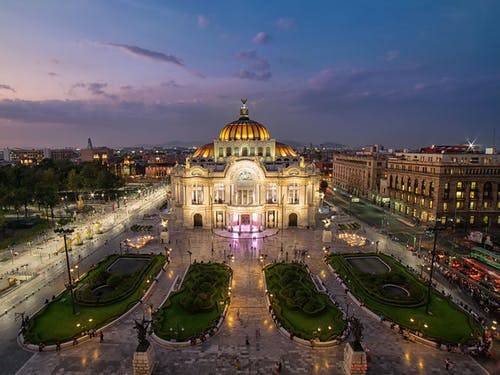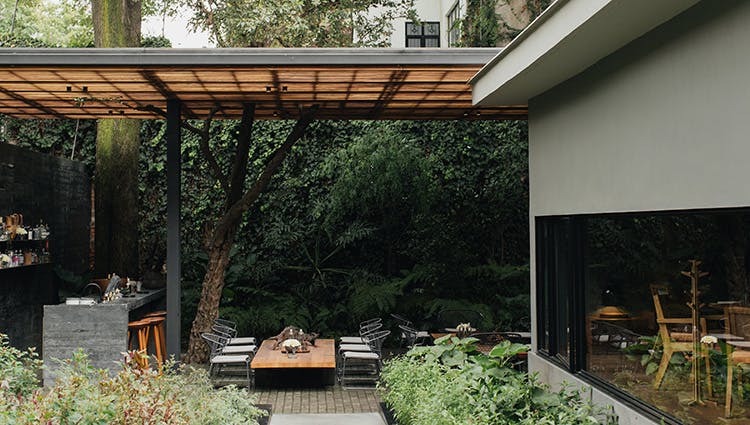When a then-24 year-old Enrique Olvera first opened Pujol in the upscale Polanco neighborhood in 2000, Mexico City did not stand out for its food. In fact, he recalls that many of the well-regarded restaurants were international chains in large hotels, like Le Cirque at the Camino Real. "There were very few Mexican restaurants doing fine dining," he says. Today, it's hard to imagine this bustling metropolis without an esteemed (and extremely Instagram-worthy) dining scene, especially since it's now home to a number of the world's best restaurants, Pujol included.
My partners and I wanted to offer the kind of food and drinks that the Mexico City we imagined would have.
According to chef Jair Téllez, there was a prevailing old-school attitude back then, and diners—as well as restaurateurs—were unwilling to take risks. This inspired him to open his first Mexico City spot, MeroToro, in 2008. (Laja, his debut project, is in Mexico's Valle de Guadalupe and has been around since 2001.) Set on a leafy street in picturesque Condesa, it's become a neighborhood standby known for surf-and-turf dishes like grilled octopus served with sweetbreads and potatoes in a rich broth you'll want to salvage with a spoon. "I was tired of going to cities around the world and having amazing food," he says. "My partners and I wanted to offer the kind of food and drinks that the Mexico City we imagined would have."
A decade later, the city of Téllez's imagination hasn't just materialized—it's surpassed his expectations. This sea change has given chefs like him and Olvera—and those who followed, like Elena Reygadas, Eduardo "Lalo" García and Pablo Salas—more opportunity for success, as well as the freedom to experiment. And after establishing themselves with higher-end restaurants, they've each recently pursued incredibly personal, and more casual, ventures.
Take Olvera's Molino el Pujol, a tiny tortilleria that opened in April on the south end of Condesa. With a handful of stools and a short corn-based menu that includes a taco, a tamal and elote, it's not a place to linger. It's a huge departure from his award-winning, tasting-menu flagship, but here, Olvera hopes to be a source for meticulously made tortillas. "It's a dream come true," he says. "I've been fantasizing about this for a long time."
Photos: Molino el Pujol
Olvera also presides over Eno, which opened in 2007 as a gourmet shop for high-quality olive oil, bread, cheese and charcuterie, as well as sandwiches and salads. Four locations later (including a new one inside Museo Jumex), the laid-back mini chain will soon introduce a menu of mostly vegetarian and vegan dishes. "I wanted a restaurant where I could eat every day, and I don't love sandwiches," Olvera says. "I also love the connections you make with people at places like Eno. At Pujol, people often go once, and you never see them again."
Reygadas had similar reasons for expanding beyond Rosetta, her 2010 restaurant. Set inside a beautifully restored building in Roma, the Italian-influenced spot has become a favorite for dishes such as cloud-like ricotta-and-lemon ravioli. While the intention was to create a relaxed restaurant serving amazing food, "at some point, it became more formal than what I wanted," she says. So in 2015—after having expanded already with two small bakeries—Lardo was born. The airy, all-day café in Condesa was an instant hit, and Reygadas says diners often stay through breakfast, lunch and dinner. As for the menu? "It's whatever I want, from eggs to pizzas to moles to curries to just everything I like together," she says. "And with its bar and open kitchen, I get to be in contact with the people."
Building off of Lardo's success, last fall Reygadas transformed her bakery in up-and-coming La Juárez into the full-service Café Nin after a neighboring space came up for rent. In addition to pastries like the must-try rosemary-sugar roll, you can get everything from punched-up versions of traditional Mexican breakfasts (chilaquiles with burrata, epazote and cilantro) to a range of sandwiches served on her cult-favorite bread.
Next door is Havre 77 , a two-year-old French bistro from García of red-hot Máximo Bistrot. The transformed 19th-century mansion has a romantic blush-pink interior, a killer raw bar and a menu of classics and blackboard specials that harkens back to the food García first learned to make as a cook in the U.S. And it's his most personal project to date. "Havre is my jewel. I wish I was there every day," he says. "I couldn't do 100 percent French at Máximo, because I wanted tourists to come, and they're not going to eat that here." (And come they did; to snag a table, reserve at least a month in advance.)
Photos: Courtesy of Máximo Bistrot
When Máximo opened in 2011, on a then-quiet corner of Roma, García's goal was to have "a simple restaurant where the check average was kind of low." But his dedication to using local ingredients—in beautifully plated dishes such as roast organic chicken and tuna crudo with serrano chile, yuzu and white soy—drove up costs. "I only work with small farmers who don't use chemicals, so my ingredients are a lot more expensive," he says. García also started employing people, growing from just four employees to about 90. Some clientele weren't happy about the higher bills—or that the restaurant was getting harder and harder to get into.
García's solution was to open Lalo! across the street in 2015. "The food still has my flavors, but it's more rustic and more affordable," he says of the lively and casual spot. But as with Havre, this decision was also partly to satisfy an inner desire. "We cooks are restless and always want more," he says. "And I wanted a place where I could make food that I would eat every day, like a burger, pizza, pasta and a really good breakfast."
--
Salas is another chef who's pursued a bifocal approach in the name of satisfying his own food preferences. In 2010, he introduced the ambitious Amaranta in his hometown of Toluca, a game changer for the colonial city about 40 miles west of Mexico City. The pricy, contemporary Mexican menu comes à la carte and as a seven-course tasting, and celebrates ingredients from the State of Mexico. But after a few years, Salas was ready to spread his wings. "Mexico is more than just one state," he says. "Plus, I was kind of stuck and needed a project that would let me try different things and cook the way I like to eat."
Photo: Amaranta
The result was Público Comedor, which launched in 2016 on the ground floor of a coworking space in Polanco. (Another outpost is set to open in Roma.) It has a fast-casual vibe: Order at the counter, seat yourself and a few minutes later, a bright salmon trout cooked with adobo chiles, a tamal with Oaxacan cheese or a colorful rice-and-veggie bowl is brought to your table. The food looks (and tastes) a lot more expensive than it is, and during the lunch rush, the stylish space buzzes with workers who appreciate the wallet-friendly prices not often found in the area.
Photo: Amaranta
For Téllez, it was his feelings about wine that drove him to open Amaya in 2016. "It was a very egotistical thing," he says. "I wanted a place that served wines I liked." The low-key, somewhat-whimsical spot does just that, with the city's first-ever all-natural list featuring his family's new biodynamic Bichi label, plus interesting bottles from Chile and across Europe. And the menu is no mere afterthought, with shareable dishes like roast cauliflower with avocado tahini and cherry tomatoes, and the addictive soft-shell crab "casino."
In January, Téllez began his latest passion project, a monthly dinner series called MesaB, for which he creates a multicourse meal for 20 guests based on ingredients he procures that morning. "The idea was sparked by being fed up with following a script and making the same dishes every day," he says. "There are so many things I cherish about restaurants, but I think they're very limiting." The experience is akin to a festive dinner party, with one long table set in an intimate, candlelit room next to Téllez's wine storage unit in a Juárez office building.
The setting is a long way from MeroToro, Pujol and the uninspired Mexico City restaurants that preceded them in the decades prior. But—perhaps more importantly—it's also a symbol of what's still to come.
Brooke Porter Katz is a Mexico City-based writer and former editor at Travel + Leisure. Her work has appeared in WSJ. Magazine, AFAR, Bloomberg Pursuits, Architectural Digest.com, among others. Follow her on Instagram at @brookeporterkatz.







